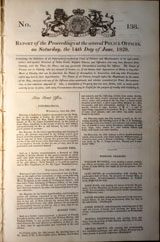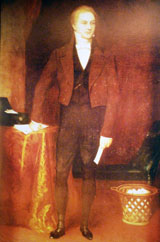Before the Police: The Police Offices
Bow Street's historic role in maintaining law and order dates back to 1740 when Sir Thomas De Veil (1684-1746) a Westminster Justice, set up rooms in his residence at 4 Bow Street for use as a magistrate’s court. From this office de Veil also took responsibility for investigating and pursuing crime. Two years after De Veil’s death Henry Fielding moved into Bow Street as a magistrate. He and his brother began to administer justice often without charge to the poorest thanks to a government grant. They established the Runners (who preferred the title of Principal Officers, as ‘runners’ made them sound like servants) and experimented with patrols along the main thoroughfares in the metropolis
The success of Bow Street finally encouraged the government to pass the Middlesex Justices Act of 1792. This established seven police offices, each staffed by three stipendiary (paid) magistrates and up to six paid officers or constables. In addition to Bow Street these offices were set up at Queen's Square (Westminster), Great Marlborough Street (Westminster), Worship Street (Shoreditch), Lambeth Street (Whitechapel), Shadwell, Union Hall (Southwark) and Hatton Garden. A river police (Thames Police Office) was created at Wapping in 1798. By 1816 there were between seven and eight officers at each station. The Shadwell Office had closed, but a new one had been opened in Marylebone High Street.
The square mile of the ancient City of London was exempt from these reforms, but it was busy developing its own police structure.
It is important to note that the passing of the 1792 Act did not herald a victory for centralization. Rather it was concerned with the speeding up of justice, as opposed to creating a new class of state magistrates. The stipendiaries were rarely involved in local affairs and so it was hard for local government agencies to exercise influence over them. At the same time, the Home Office rarely interfered in these matters.
The police offices established in 1792 played a role in policing until 1839. Many of their constables joined the new Metropolitan Police; and some Metropolitan police officers transferred to these offices as constables during the ten years that they co-existed. After 1839 the police offices themselves continued as magistrates’ courts.
By 1800 the Bow Street night-time Foot Patrol was 68 men. They policed the main metropolitan thoroughfares and roads into London. Five years later a mounted patrol joined them for speed in deterring and preventing highway robberies. A Dismounted Horse Patrol was in use for nearby suburbs in 1821, and a Day Patrol of 27 men was established the following year. Both of these groups were set up by the Home Secretary. By 1822 the Bow Street patrols numbered 288 men. The main role of the officers was detecting crime and apprehending offenders.

There were problems with some of the Bow Street police. Corruption was a significant issue. In 1816 George Vaughan, a member of the Bow Street Horse Patrol, was sentenced to five years’ hard labour for setting up five men for a burglary in Hoxton. He arrested them in the act for a reward of £40 per man. Known thieves were apprehended even though they had committed no offence. The runners also devoted much of their attention to crime outside London, chasing high rewards from rich men and institutions. The police offices acted independently of each other, and jealous rivalries surfaced. However, these offices also shared information with each other, placing knowledge of stolen goods in the public domain. For an example see the report for Saturday 14th June 1828.
A number of parliamentary select committees were established to inquire into policing in London. They are a useful source of information about the workings of the police offices: for example the evidence given by Sir Nathaniel Conant on Saturday 26th April 1816 and Samuel Taunton on 2nd May 1817.
Notes
A guinea was worth £1 and 1 shilling (there were 12 old pence to the shilling, and 20 shillings in a pound).
A flash-house refers to relatively safe meeting place used by criminals, which provided entertainment including alcohol, gambling and women. These houses were also a place to conduct business with other criminals such as receivers, who received and sold-on stolen goods.
 Sir Robert Peel
Sir Robert Peel